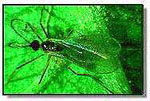|
A Comprehensive Guide to Safe Biological Pest Control |
* Ask a Question * |
| Home About FAQ Quick Reference | |
NATURAL PEST CONTROL WITH APHIDOLETES
 Aphidoletes is a small midge (fly) that feed on over 60 species of aphids. The adults are free living, and the larval stages feed on aphids. It feeds by biting aphids in the leggs and paralizing them with a toxin before sucking out the aphid body fluids. If aphid populations are high, Aphidoletes will kill more aphids than they actually consume. They can be used in a variety of cultivated crops, and is perhaps under utilized for biocontrol of a variety of cropping systems.
Aphidoletes is a small midge (fly) that feed on over 60 species of aphids. The adults are free living, and the larval stages feed on aphids. It feeds by biting aphids in the leggs and paralizing them with a toxin before sucking out the aphid body fluids. If aphid populations are high, Aphidoletes will kill more aphids than they actually consume. They can be used in a variety of cultivated crops, and is perhaps under utilized for biocontrol of a variety of cropping systems.
Aphidoletes adults are not strong flyers, so they fly during the night when the air is calm. The adults are 2-3 mm (1/16 inch) long, and have distinctive long legs.
 Females deposit 150-200 eggs on leaves adjacent to aphid colonies. The eggs are oval and shiny orange-red. The developing larvae will be orange colored, but may be brownish or grayish depending upon stomach contents. Larval stages are maggots which crawl on the leaf surface in search of aphid prey. Larvae may consume 3-50 aphids per day. When fully grown, the larvae are 3.0 mm (1/10 inch) long, but can be easily seen amoung the aphid prey because of their color.
Females deposit 150-200 eggs on leaves adjacent to aphid colonies. The eggs are oval and shiny orange-red. The developing larvae will be orange colored, but may be brownish or grayish depending upon stomach contents. Larval stages are maggots which crawl on the leaf surface in search of aphid prey. Larvae may consume 3-50 aphids per day. When fully grown, the larvae are 3.0 mm (1/10 inch) long, but can be easily seen amoung the aphid prey because of their color.
Total generation time from egg to adult takes nearly 3-5 weeks. Only the larval stage is predaceous. It feeds by biting aphids in the legs and paralizing them with a toxin before sucking out the aphid body fluids. If aphid populations are high, Aphidoletes will kill more aphids that they actually consume. Adult Aphidoletes feed on aphid honeydew. Ants protect aphids and should be controlled.
For home gardens apply 250 Aphidoletes 1 or 2 times, 2 weeks apart.
For greenhouses apply 1 Aphidoletes per 1-6 plants.
For orchards use 2-5 Aphidoletes per tree.
